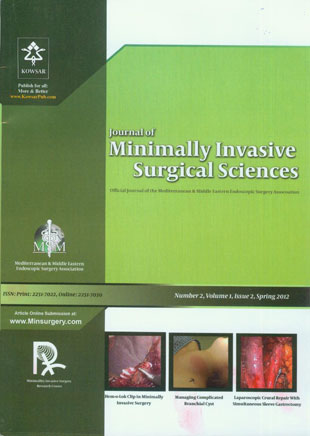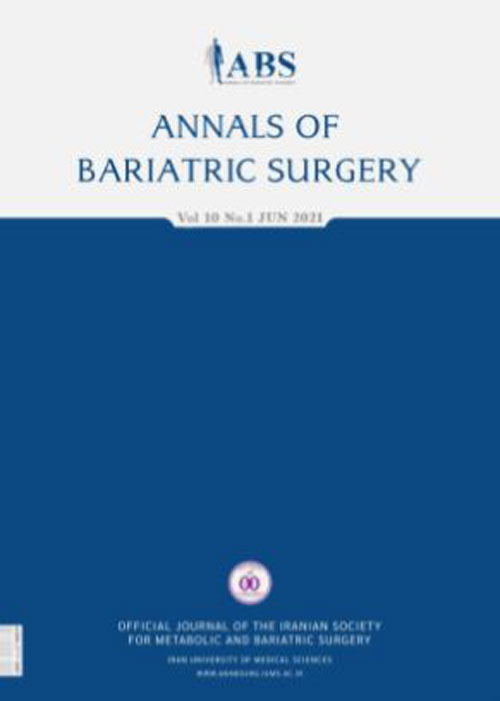فهرست مطالب

Annals of Bariatric Surgery
Volume:1 Issue: 2, Spring 2012
- 90 صفحه،
- تاریخ انتشار: 1391/04/10
- تعداد عناوین: 10
-
-
Page 8BackgroundThere are several methods for the ligation of structures during minimally invasive operations. The hem-o-lok clip is a nonabsorbable polymer clip with a lock engagement feature. There are few reports about its use in minimally invasive general surgical procedures.ObjectivesIn this report, we describe our experience with the hem-o-lok clip during basic, minimally invasive, general surgery procedures and the adverse events during application of the hem-o-lok.Patients andMethodsWe retrospectively reviewed all laparoscopic appendectomies (LAs), cholecystectomies (LCs), and splenectomies (LSs), performed by 6 general surgeons at a university-affiliated hospital over 4 years. Clip failure was defined as intraoperative or postoperative bleeding due to clip malfunction that necessitated placement of another clip, conversion to an open procedure, or postoperative re-exploration. Leakage from the cystic duct and appendiceal stump was also considered clip failure. A search of the US Food and Drug Administration Manufacturer and User Facility Device Experience (MAUDE) database using the appropriate keywords was performed on July 7, 2011. This online resource contains reports of adverse events involving medical devices.ResultsOver a 4-year period, 856 laparoscopic operations, comprising 770 LC, 55 LS, and 31 LA, were performed. We did not observe any incidence of clip failure. There were 22 reports of hem-o-lok clip failure in the MAUDA database. Eighty-two percent (n = 18) of clip failures were reported during laparoscopic nephrectomy. There was no report of failure after LA. There were 2 reported clip failures after LC (with bile leakage) and 1 after LS (tearing of splenic vessels with intraoperative bleeding). There was also a report of migration of the hem-o-lok clip into the common bile duct, which occurred 4 years after a complicated LC.ConclusionsHem-o-lok clips that are properly applied during basic laparoscopic procedures are a secure option for the ligation of the structures. Surgeons must be educated regarding the proper application technique.Keywords: Surgical Instruments, Laparoscopy, Surgical Procedures, Minimally Invasive, Cholecystectomy, Appendectomy, Splenectomy, Nephrectomy
-
Page 58BackgroundDeep Venous Thrombosis (DVT) is a major risk of morbidity and mortality in morbid obese patients underwent bariatric surgery. There are some controversies in different kind of prophylactic strategies for DVT in laparoscopic bariatric surgeries. Unfractionated heparin (UFH) is an available and reversible anticoagulant used for DVT prophylaxis.ObjectivesThis study aimed to compare clinical results of two different dosage regimes of unfractionated heparin for short term prophylaxis of DVT after bariatric surgery.Patients andMethods139 patients with morbid obesity who underwent laparoscopic bariatric surgery (laparoscopic Roux-en-Y gastric bypass, sleeve gastrectomy, and laparoscopic gastric banding) were evaluated in two groups: group A received 5000 IU unfractionated heparin q12h and group B received the same dose but q8h (preliminary dose received before induction of anesthesia followed by 2 or 3 times daily). All patients were evaluated by physical examination and Doppler ultra sound for DVT before and 10 days after surgery.ResultsThere was no statistically significant difference between two groups in venous thrombosis. No thrombotic events were observed before and after operations. There were no heparin induced thrombocytopenia and no meaningful difference between two groups in postoperative bleeding.ConclusionsThis study showed that in combination with non-pharmacologic methods for prevention of thromboembolic events, both regimes of UFH prophylaxis had similar clinical effects.Keywords: Heparin, Obesity, Bariatric Surgery, Venous Thrombosis
-
Page 62BackgroundSurgeon’s depend to a large degree on the amount of blood loss and a clear view of the surgical field, when conducting endoscopic procedures in order to achieve satisfactory outcomes. The anesthesiologist’s choice of method for the induction and maintenance of anesthesia plays a major role in achieving this goal.ObjectivesThis study was performed in order to compare the two most well-known methods in this regard; total intravenous anesthesia (TIVA) and venous inhalational mixed anesthesia (VIMA).Patients andMethodsThis study included the endoscopic management of 89 patients with cerebrospinal leakage (CSF leakage) covering a period of nine years (1999-2008) for whom a subarachnoid injection of fluorescein was first administered, and afterwards they were maintained under general anesthesia using two distinct methods; propofol-remifentanil versus isoflurane–remifentanil (inhalational or intravenous). During the operation, hemodynamic indices, blood loss, and surgeon’s satisfaction, were assessed and compared between the two groups.ResultsEndoscopic management and autografts were successful in repairing anterior skull defects in 90% of cases. Regarding the surgeon’s satisfaction level, and hemodynamic stability no significant difference between the two groups was observed (P > 0.01).ConclusionsBoth isoflurane and propofol in combination with remifentanil afford optimal surgical conditions with regard to hemodynamic parameters and the satisfaction of the surgeon with the surgical field.Keywords: Cerebrospinal Fluid, Propofol, Remifentanil, Isoflurane, Endoscopy
-
Page 67BackgroundLaparoscopic sleeve gastrectomy (LSG) has become popular both as a definitive and a staged procedure for morbid obesity. Gastroesophageal reflux disease (GERD) is a common co-morbid disease in bariatric patients.ObjectivesThe aim of this study was to evaluate the efficacy of LSG and hiatal hernia repair (HHR) to treat obesity, complicated by hiatus hernia (HH).Patients andMethodsThe participants in the study were twenty patients, 14 women and 6 men, with a mean body mass index of 43.4 ± 1.9 kg/m2 and mean age of 47 years. All the subjects were eligible for LSG and eight were found to have esophagitis at pre-operative endoscopy. Patients with Barrett’s esophagus were excluded. GERD symptom questionnaire, 24-hour esophageal pH-metry, and manometry were employed as Pre-and post-procedure assessments. The mean follow-up period was eight months. Clinical outcomes were also evaluated in terms of GERD symptoms improvement or resolution, interruption of antireflux medication, and X-ray evidence of HH recurrence.ResultsSymptomatic HH was diagnosed preoperatively in 18 patients. In the other two patients, HH was asymptomatic and was diagnosed intra-operatively. Prosthetic reinforcement of crural closure was performed in two symptomatic cases with an HH > 5 cm. Mortality was nil and no complications occurred. After a mean follow-up of seven months, GERD symptoms resolution occurred in nine patients, while the other patients reported an improvement of reflux. Body mass index had fallen from 43.4 to 36.2 kg/m2.ConclusionsA laparoscopic hiatal repair with or without commercially available onlay reinforcement biologic mesh and a sleeve gastrectomy performed at the same time, was successful in controlling the reflux symptoms and reducing body weight.Keywords: Laparoscopy, Hernia, Hiatal, Gastrectomy
-
Page 74Appendicitis after age 40 is unusual, and appendicitis two days after laparoscopic hysterectomy is very rare and has not been reported to date. We describe a 44-year-old woman who had abdominal pain two days after laparoscopic hysterectomy. The pathology report indicated early appendicitis and the pain disappeared after appendectomy. In our opinion, the cause of appendicitis may have been related to the use of monopolar and bipolar coagulation during laparoscopic hysterectomy, although the coincidence of appendicitis and laparoscopic surgery may be accidental.Keywords: Appendicitis, Electrosurgery, Hysterectomy, Laparoscopy
-
Page 77In this study we present successful management of an inflamed branchial cyst by stripping the inner lining thus providing a safe and definitive treatment. We believe that this is the first report of this technique in the literature.Keywords: Branchioma, Cystectomy, Inflammation


